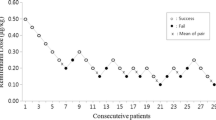Abstract
Purpose
We hypothesized that the simultaneous use of low concentrations (<6%) of desflurane, nitrous oxide (N2O), and fentanyl would allow a laryngeal mask airway (LMA) to be inserted safely with inhalation induction of desflurane, even in nonparalyzed patients. This prospective, observational study was performed to determine the 50% effective concentration (EC50) of desflurane for LMA insertion in such patients.
Methods
Twenty-two adult patients undergoing ambulatory surgical procedures under general anesthesia using an LMA were included in the study. Fentanyl was administered intravenously at 1.5 μg·kg−1, and anesthesia was induced with desflurane in 50% N2O and oxygen, using a normal tidal volume breathing technique. Subsequently, a preselected steady-state end-tidal desflurane concentration was maintained for 10 min before insertion of the LMA. Successful LMA insertion was defined as the absence of adverse airway responses until cuff inflation. Target concentrations of desflurane for LMA insertion were determined using a modified Dixon’s up-and-down method (starting dose, 5%; step size, 0.5%).
Results
All 22 patients completed the study without adverse events related to airway irritation. The EC50 of desflurane for insertion of the LMA was determined to be 3.61 ± 0.31%, and the 95% confidence interval (CI) of the EC50 obtained using probit analysis was 3.13–3.90.
Conclusion
We demonstrated that N2O-desflurane inhalation induction with a normal tidal breathing technique after premedication with fentanyl can be used safely without any adverse airway events in nonparalyzed patients. In such patients, the EC50 of desflurane for successful LMA insertion was 3.61 ± 0.31% (95% CI, 3.13–3.90).
Similar content being viewed by others
References
Ghatge S, Lee J, Smith I. Sevoflurane: an ideal agent for adult day-case anesthesia? Acta Anaesthesiol Scand. 2003;47:917–931.
Leong WM, Ong EL. Laryngeal mask airway can be inserted with inhaled desflurane induction. J Anesth. 2005;19:112–117.
Kong CF, Chew ST, Ip-Yam PC. Intravenous opioids reduce airway irritation during induction of anaesthesia with desflurane in adults. Br J Anaesth. 2000;85:364–367.
Kelly RE, Hartman GS, Embree PB, Sharp G, Artusio JF Jr. Inhaled induction and emergence from desflurane anesthesia in the ambulatory surgical patients: the effect of premedication. Anesth Analg. 1993;77:540–543.
Bunting HE, Kelly MC, Milligan KR. Effect of nebulized lignocaine on airway irritation and haemodynamic changes during induction of anaesthesia with desflurane. Br J Anaesth. 1995;75: 631–633.
Jones RM. Desflurane and sevoflurane: inhalation anaesthetics for this decade? Br J Anaesth. 1990;65:527–536.
Saros GB, Doolke A, Anderson RE, Jakobsson JG. Desflurane vs sevoflurane as the main inhaled anaesthetic for spontaneous breathing via a laryngeal mask airway for varicose vein day surgery: a prospective randomized study. Acta Anaesthesiol Scand. 2006;50:549–552.
Wadhwa A, Durrani J, Sengupta P, Doufas AG, Sessler DI. Women have the same desflurane minimum alveolar concentration as men: a prospective study. Anesthesiology. 2003;99: 1062–1065.
Gold MI, Abello D, Herrington C. Minimum alveolar concentration of desflurane in patients older than 65 years. Anesthesiology. 1993;79:710–714.
Dixon WJ. Staircase bioassay: the up-and-down method. Neurosci Biobehav Rev. 1991;15:47–50.
Lichtman AH. The up-and-down method substantially reduces the number of animals required to determine antinociceptive ED50 values. J Pharmacol Toxicol Methods. 1998;40:81–85.
Choi SC. Interval estimation of the LD50 based on an up-and-down experiment. Biometrics. 1990;46:485–492.
Bailey JM. Context-sensitive half-times and other decrement times of inhaled anesthetics. Anesth Analg. 1997;85:681–686.
Mahmoud NA, Rose DJ, Laurence AS. Desflurane or sevoflurane for gynaecological day-case anaesthesia with spontaneous respiration? Anaesthesia. 2001;56:171–174.
Bonnin M, Therre P, Albuisson E, Beaujard H, Barthelemy I, Mondie JM, Bazin JE. Comparison of a propofol target-controlled infusion and inhalational sevoflurane for fibreoptic intubation under spontaneous ventilation. Acta Anaesthesiol Scand. 2007;51:54–59.
Weiskopf RB, Moore MA, Eger EI II, Noorani M, McKay L, Chortkoff B, Hart PS, Damask M. Rapid increase in desflurane concentrations is associated with greater transient cardiovascular stimulation than with rapid increase in isoflurane concentration in humans. Anesthesiology. 1994;80:1035–1045.
Wilkes AR, Hall JE, Wright E, Grundler S. The effect of humidification and smoking habit on the incidence of adverse airway events during deepening of anaesthesia with desflurane. Anaesthesia. 2000;55:685–689.
Weiskopf RB, Eger EI II, Noorani M, Daniel M. Fentanyl, esmolol, and clonidine blunt the transient cardiovascular stimulation induced by desflrane in humans. Anesthesiology. 1994; 81:1350–1355.
Kihara S, Yaguchi Y, Inomata S, Watanabe S, Brimacombe JR, Taguchi N, Komatsuzaki T. Influence of nitrous oxide on minimum alveolar concentration of sevoflurane for laryngeal mask airway insertion. Anesthesiology. 2003;99:1055–1058.
Bjorkman S, Stanski DR, Verotta D, Harashima H. Comparative tissue concentration profiles of fentanyl and alfentanil in humans predicted from tissue/blood partition data obtained in rats. Anesthesiology. 1990;72:865–873.
Shafer SL, Varvel JR. Pharmacokinetics, pharmacodynamics, and rational opioid selection. Anesthesiology. 1991;74:53–63.
Mendonca C, Thorpe C. Effect of smoking on induction of anaesthesia with sevoflurane. Anaesthesia. 2001;56:19–23.
McKay RE, Bostrom A, Balea MC, McKay WR. Airway responses during desflurane versus sevoflurane administration via a laryngeal mask airway in smokers. Anesth Analg. 2006;103: 1147–1154.
Author information
Authors and Affiliations
About this article
Cite this article
Shin, HY., Lim, JA., Kim, SH. et al. Desflurane requirements for laryngeal mask airway insertion during inhalation induction. J Anesth 23, 209–214 (2009). https://doi.org/10.1007/s00540-008-0730-3
Received:
Accepted:
Published:
Issue Date:
DOI: https://doi.org/10.1007/s00540-008-0730-3




